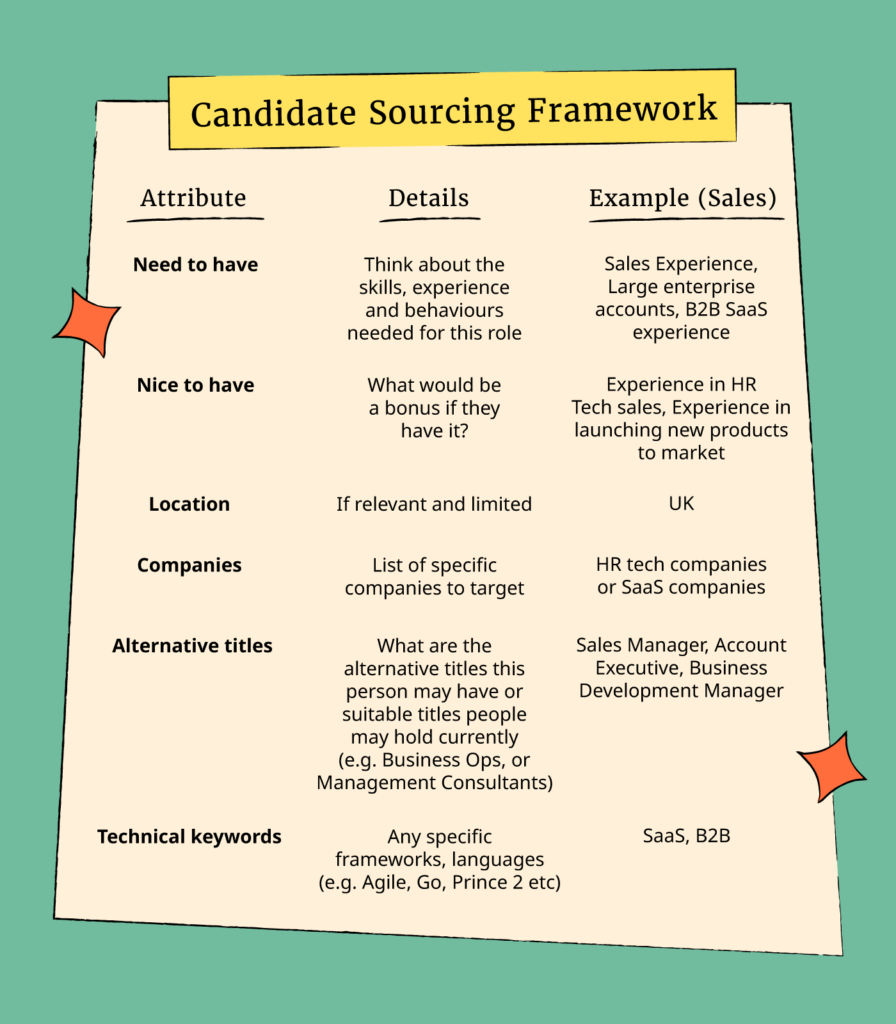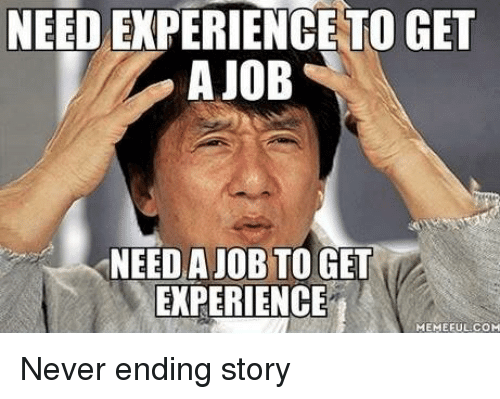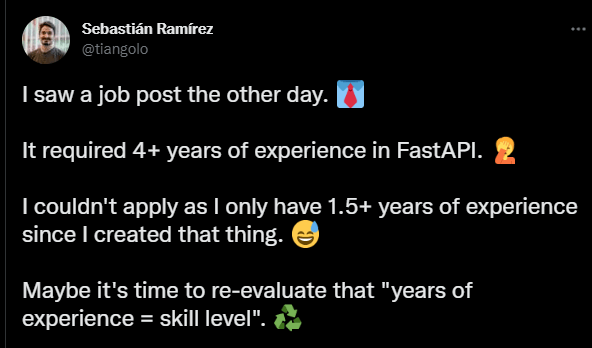There are many different formats of job description—informative, mission-driven, role-focused, short-form, or emoji-riddled.
The best job descriptions, in my opinion, combine a little of all of these.
Here's how to write an effective job description that will attract the right candidates for your roles, with specific examples from my experience.
Let’s dive in.
What is a job description?
A job description is a document that outlines the job requirements, skills, qualifications, activities, responsibilities, and duties of a specific role within a company. It may also include details like the salary range
Sometimes called a 'JD,' the purpose of a job description is to advertise your role to potential candidates and inform them both about the role and your organization.
It should have enough information to pique a job seeker’s interest and motivate them to move forward with the hiring process.
It's also a chance to give a glimpse into your company's culture, mission, and values.
With that in mind, here's how to write one.
How to write a job description
A job description serves several purposes—it "sells" a job opportunity to prospective candidates, aligns the business and employee on the scope of a role, and serves as a guideline for an employee's key areas of responsibility.
Here's how to put all the pieces together.
Step 1: Create a simple and easily understood job title.
Start with the job title of the role. My mantra is to go for simple and easily understood language.
If there is already a naming convention for a particular role, there is no need to go creative with the job title. Otherwise, people will have trouble identifying their suitability from the title.
Example
If the role is an Account Manager, call it that rather than a "Customer Relationship Guru" or something.
Step 2. Define responsibilities and outcomes.
These are the responsibilities of the role and how they contribute to your company mission. Candidates crave this information!
If you are stuck with creating the responsibilities, create a long list of all the job specifications you can think of that the person in this role will have to complete.
You can use a similar framework to the one you’d create for your candidate sourcing strategy to help you structure your thoughts.

Then, shorten the laundry list of job duties you’ve come up with. The goal is to be informative but not to overload with information. 4-6 bullet points for responsibilities, and the same for skills, is a good benchmark.
After deciding on what responsibilities you’re going to include, think back to your mission as a company. Perhaps you have some OKRs or goals for the team that these duties will contribute towards.
Start creating these as outcomes and add them to the list. This way, you can link a specific set of responsibilities to an outcome.
Examples
Let's say you're hiring a Tech Talent Partner. You might include these responsibilities and desired outcomes in the job description:
- Source, engage, and screen candidates in the product and engineering space to help us scale from X to XX number in the next 9 months.
- Work with hiring managers to create hiring and onboarding plans and priorities to support scaling and growth, as well as ensure a great experience for the new hires.
Keep linking back to the company mission and why you exist. This creates a sense of belonging for the role and, by extension, a sense of belonging in the potential candidate reading it.
Step 3. Outline the necessary skills and attributes.
From there, start thinking about the skills, relevant experience, education, certifications, and attributes required for a person to be considered a qualified candidate.
This really has to be targeted to the audience for your open position.
Skills and attributes for entry-level roles
If you're hiring for an entry-level role, don't put down 2-3 years of experience in X.
This "needs experience to get experience" catch-22 is so prevalent that it's been turned into a popular meme.

For an entry-level role, focus more on the attributes and ambitions of the prospective candidate.
Example
For an entry-level admin role, include things like:
- Attention to detail
- Organization
- Ability to prioritize
Experience in these can come in many forms and doesn't necessarily have to stem from previous admin work.
Skills and attributes for non-entry-level roles
For non-entry-level roles, you'll need to include specific experience, requirements, or even qualifications to attract the right candidates.
Specifying the minimum years of experience is a divisive topic. Some companies swear by it, and others prefer to leave it vague.
One pitfall to watch out for, however, is not to ask for more years of experience than the technology has been around, as in the below example:

This one I will leave to you, as I see both sides of the argument. Personally, I do think that a rough guide can be useful to people but should not be treated as gospel, and I lean away from using it.
Step 4. Highlight why your company is a great place to work.
The better the candidate, the more career options they have. While it’s important to provide information about the job, it’s just as important to give potential applicants a taste of what your company culture has to offer. Consider adding a summary and a few bullet points on the following attributes:
- Company mission and values
- Type of work environment (i.e. in-office, remote, or hybrid)
- Perks (i.e. casual dress codes or free lunches on Fridays)
- Benefits packages (i.e. health insurance, dental, and mental health coverage)
- Health and wellness initiatives
- Opportunities for career development
- Vacation and paid time off policies
- Policies around equitable and/or diverse hiring
Consider that your job listing is advertising your company as a whole, and not just the open role. Remember, you’re competing for top talent just as much as the best candidates are competing with each other!
What is the perfect job description format?
Now that we have what content will go in the job description, it's time to think about the format. Based on my experience, these best practices do a great job of polishing your job descriptions and laying a solid foundation for the JDs you write in the future.
Create a standard job description template
This is where you pull in your employer branding and, ideally, work with your marketing manager.
You are looking to create an identity where certain things are standardized and recognizable—for example, headings to guide the eye through the page and the company information.
Usually, with my own job description templates, I use the following outline.
Example Job Description Template
- Overview—This is a one-two sentence attention grabber, plus a bit more on the conditions and location for the role (e.g. Remote +/- X hrs of this timezone, full-time, 9-month contract).
- About the role—this is where the responsibilities and outcomes go
- About you—this is where the requirements go
- About the company—some companies put this at the start, some towards the end, but it’s entirely up to you and your company's journey. This is where your mission and your company culture get to shine.
- EEOC statement—in some jurisdictions this is a must, so make sure you have one. In general, there are many examples you can copy. I’m a fan of writing one for your own company, and how diversity and inclusion is part and parcel of the company.
Use a consistent tone of voice
The tone of voice is also something that marketing can help you with, as it's a component of an employer's brand identity. If you're not familiar with what I mean by 'tone of voice,' here are a few examples of the role tone plays in job descriptions.
Tone of voice examples
- You vs passive voice. I am a big fan of using "You" in job descriptions. I think it creates a closeness with the candidate and helps visualize and humanize the experience. This is in contrast to passive voice, which reads instead like, "the ideal candidate for this position shall have..."
- Formality of language. Some businesses communicate with a very formal tone, and others use more relaxed language—both are fine, and both communicate something about the org's culture. But if your company's tone of voice is informal and your job descriptions read like a Royal Gala invitation, you can unintentionally misrepresent your company and confuse candidates.
What should I watch out for when creating a job description?
Some common errors and frustrations I have when reviewing and posting job descriptions.

Filler requirements
I am of the firm belief that if all you write is "great communication skills" or "attention to detail" you don't know the person who needs to be in the role well enough.
You need to think about what kinds of communication skills are required and be more explicit.
For example, a Product Manager might need to have "demonstrated cross-functional communication skills where they are able to understand business and technical needs alike".
This gives more of a guidance.
Education requirements
This is a touchy subject but, what I will say is, think about what is absolutely necessary.
If there is a requirement for a specific qualification or certification, it absolutely makes sense to mention it.
But a "2:1 grade minimum from a top 20 university" is incredibly exclusionary. We should try to move away from this practice, especially in the face of so many alternative routes to a career.
Formatting on job boards
Be mindful of how your format may appear on different job boards. Many times I’ve laboured over beautiful headings and bullet point formatting, only for the job board to paste a wall of text when you look at the job posting.
Look around for a preview button, the formatting rules of the job board (usually on the page with the editor), or at least make sure that you view the live posting right after you post to verify formatting.
Salary range
In more and more jurisdictions it's a requirement to post a salary banding or salary range in a JD.
I think this is an interesting move to level the playing field and give more power to candidates when negotiating. If you intent to adjust salaries depending on the location of a remote candidate, make sure you specify that.
What tools can I use to write a job description?
Writing a job description from scratch can result in a bad case of 'blank page syndrome,'—the affliction of staring at a blank page and finding your mind has gone equally blank. Here are a few tools that can help you:
Read other job descriptions to get a starting point
As simple as it may sound, if you are truly stuck on getting started with describing a role (seen this happen many times for junior or operational roles), have a look at how other companies are describing it.
Take a look at a few examples from competitors, and perhaps a few from completely unrelated companies, to see what the similarities and differences are (e.g. if you are a B2B SaaS company, take a look at how consumer goods businesses write about this role).
Use a gender decoder to spot exclusionary language
Studies upon studies have found two major differences in the way men and women apply for jobs.
Women, on the whole, try to match 100% of the requirements for a role before they apply (hence why you summarise and keep to fewer bullet points) and they are less likely to respond to overly aggressive or exclusionary language.
Recently I saw "He/She will join a 4-man team". Well done on the He/She (better would be You), but then they let themselves down with the 4-man team. Is it a turn of phrase—yes. Can it be exclusionary—also yes.
There are multiple tools for this. Datapeople and Textio are paid tools with advanced functionalities like languages decoders and some forms of AI (e.g they recognize turns of phrase) and Genderdecoder is simpler but free.
It may surprise you what can be considered an exclusionary language, especially if you've never needed to scrutinize your writing. A recent study found that language can even impact the average age of your applicants too.
Leverage software to recruit the right candidates
Lastly, some applicant tracking systems (ATS) also have tips on how to optimize your ads for SEO so that they appear to the right people. Make sure to check those and, if you do have an internal SEO specialist, perhaps check with them on what else you can do.
If you're hiring for a larger organization, tools like enterprise recruitment software are invaluable for tracking and managing candidates in various stages of the recruitment process.
Job Description Example
Here’s a fictional job description example for an HR manager position at a software company.
HR Manager at TechSolutions Inc.
Location: San Francisco, CA (Hybrid)
Company Overview: TechSolutions Inc. is a leading software company dedicated to creating innovative solutions that transform industries. We are driven by a passion for technology and a commitment to excellence.
Role Overview:
As the HR Manager at TechSolutions Inc., you will play a pivotal role in shaping our company culture, fostering talent, and driving HR initiatives that support our mission and values.
Role and Responsibilities:
- Develop and implement HR strategies aligned with company objectives
- Oversee recruitment processes, from sourcing to onboarding
- Design and execute employee development programs and training
- Manage performance appraisal systems and career progression plans
- Ensure compliance with labor regulations and company policies
- Handle employee relations and conflict resolution effectively
- Champion diversity, equity, and inclusion initiatives within the company
- Collaborate with cross-functional teams for HR-related projects
Requirements
Skills and Qualifications
- Bachelor's degree in Human Resources or related field
- Proven experience (5+ years) in HR management roles
- Strong knowledge of employment laws and HR best practices
- Excellent communication and interpersonal skills
- Ability to work in a fast-paced, dynamic tech environment
- Strategic thinker with problem-solving abilities
- HR certification (e.g., SHRM-CP, PHR) is a plus
Benefits:
- Competitive salary package
- Comprehensive health, dental, and wellness benefits
- Annual company retreat
- Flexible work arrangements
- Opportunities for professional growth and development
Application Process:
To apply, please submit your resume and cover letter to TechSolutions Careers indicating your interest in the HR Manager position.
TechSolutions Inc. is an equal-opportunity employer and values diversity in the workplace.
Job Description Best Practices
Keeping all of the above in mind, there are a few universal best practices for creating a good job description. Here’s a summary of the fundamentals.
Keep it simple
Use simple and accessible language (unless you are talking about specific technical terms). No one will be impressed with you if they need a thesaurus to understand your job description —unless you are hiring a thesaurus writer!
Keep it shorter
Every role has a mountain of duties and tasks to cover. But, if you write out everything you will get a wall of text which few people will read. Bullet points are your best friend, and it is very possible to group some tasks together and summarise them in one bullet point (see the Tech Talent Partner example above).
Link responsibilities to outcomes
Try to help the person visualize themselves in the role by linking back the responsibilities to outcomes and the outcomes to team or company goals. You want to make sure that the right candidate is already imagining how they will grow with your company.
Closing thoughts
Job descriptions are a great opportunity to show a potential employee how they will fit into the overall puzzle of your company, whether they're destined to be a remote team member or seeing you every day at the office.
When you sit down to write a job description, try to really focus and think “what would you want to read to be able to make a decision on whether or not to apply for the role?
It’s your opportunity to really highlight the things that are important to you. If you treat it like a window into your company, make sure you don’t only give a glimpse but a full panoramic view!
To remain up to date on all the latest in People Management, subscribe to our newsletter. You'll receive insights and offerings tailored to leaders and HR professionals straight to your inbox.


